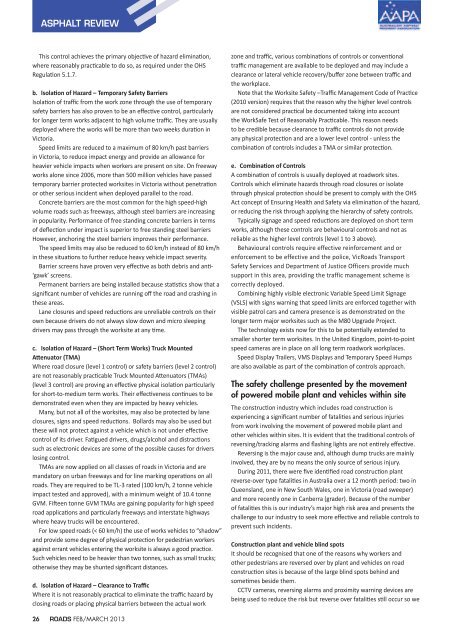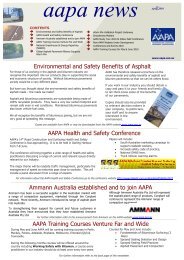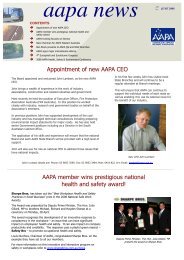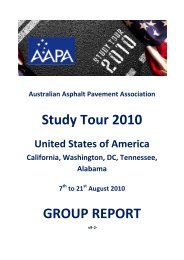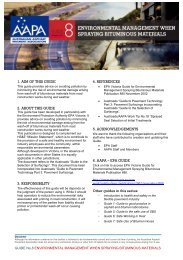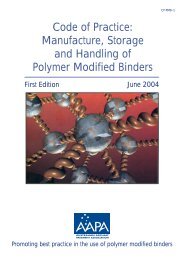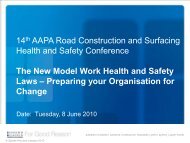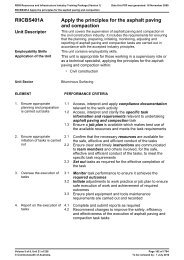Asphalt Review - Feb/March 2013 - Australian Asphalt Pavement ...
Asphalt Review - Feb/March 2013 - Australian Asphalt Pavement ...
Asphalt Review - Feb/March 2013 - Australian Asphalt Pavement ...
Create successful ePaper yourself
Turn your PDF publications into a flip-book with our unique Google optimized e-Paper software.
ASPHALT REVIEW<br />
This control achieves the primary objective of hazard elimination,<br />
where reasonably practicable to do so, as required under the OHS<br />
Regulation 5.1.7.<br />
b. Isolation of Hazard – Temporary Safety Barriers<br />
Isolation of traffic from the work zone through the use of temporary<br />
safety barriers has also proven to be an effective control, particularly<br />
for longer term works adjacent to high volume traffic. They are usually<br />
deployed where the works will be more than two weeks duration in<br />
Victoria.<br />
Speed limits are reduced to a maximum of 80 km/h past barriers<br />
in Victoria, to reduce impact energy and provide an allowance for<br />
heavier vehicle impacts when workers are present on site. On freeway<br />
works alone since 2006, more than 500 million vehicles have passed<br />
temporary barrier protected worksites in Victoria without penetration<br />
or other serious incident when deployed parallel to the road.<br />
Concrete barriers are the most common for the high speed-high<br />
volume roads such as freeways, although steel barriers are increasing<br />
in popularity. Performance of free standing concrete barriers in terms<br />
of deflection under impact is superior to free standing steel barriers<br />
However, anchoring the steel barriers improves their performance.<br />
The speed limits may also be reduced to 60 km/h instead of 80 km/h<br />
in these situations to further reduce heavy vehicle impact severity.<br />
Barrier screens have proven very effective as both debris and anti-<br />
‘gawk’ screens.<br />
Permanent barriers are being installed because statistics show that a<br />
significant number of vehicles are running off the road and crashing in<br />
these areas.<br />
Lane closures and speed reductions are unreliable controls on their<br />
own because drivers do not always slow down and micro sleeping<br />
drivers may pass through the worksite at any time.<br />
c. Isolation of Hazard – (Short Term Works) Truck Mounted<br />
Attenuator (TMA)<br />
Where road closure (level 1 control) or safety barriers (level 2 control)<br />
are not reasonably practicable Truck Mounted Attenuators (TMAs)<br />
(level 3 control) are proving an effective physical isolation particularly<br />
for short-to-medium term works. Their effectiveness continues to be<br />
demonstrated even when they are impacted by heavy vehicles.<br />
Many, but not all of the worksites, may also be protected by lane<br />
closures, signs and speed reductions. Bollards may also be used but<br />
these will not protect against a vehicle which is not under effective<br />
control of its driver. Fatigued drivers, drugs/alcohol and distractions<br />
such as electronic devices are some of the possible causes for drivers<br />
losing control.<br />
TMAs are now applied on all classes of roads in Victoria and are<br />
mandatory on urban freeways and for line marking operations on all<br />
roads. They are required to be TL-3 rated (100 km/h, 2 tonne vehicle<br />
impact tested and approved), with a minimum weight of 10.4 tonne<br />
GVM. Fifteen tonne GVM TMAs are gaining popularity for high speed<br />
road applications and particularly freeways and interstate highways<br />
where heavy trucks will be encountered.<br />
For low speed roads (< 60 km/h) the use of works vehicles to “shadow”<br />
and provide some degree of physical protection for pedestrian workers<br />
against errant vehicles entering the worksite is always a good practice.<br />
Such vehicles need to be heavier than two tonnes, such as small trucks;<br />
otherwise they may be shunted significant distances.<br />
d. Isolation of Hazard – Clearance to Traffic<br />
Where it is not reasonably practical to eliminate the traffic hazard by<br />
closing roads or placing physical barriers between the actual work<br />
zone and traffic, various combinations of controls or conventional<br />
traffic management are available to be deployed and may include a<br />
clearance or lateral vehicle recovery/buffer zone between traffic and<br />
the workplace.<br />
Note that the Worksite Safety –Traffic Management Code of Practice<br />
(2010 version) requires that the reason why the higher level controls<br />
are not considered practical be documented taking into account<br />
the WorkSafe Test of Reasonably Practicable. This reason needs<br />
to be credible because clearance to traffic controls do not provide<br />
any physical protection and are a lower level control - unless the<br />
combination of controls includes a TMA or similar protection.<br />
e. Combination of Controls<br />
A combination of controls is usually deployed at roadwork sites.<br />
Controls which eliminate hazards through road closures or isolate<br />
through physical protection should be present to comply with the OHS<br />
Act concept of Ensuring Health and Safety via elimination of the hazard,<br />
or reducing the risk through applying the hierarchy of safety controls.<br />
Typically signage and speed reductions are deployed on short term<br />
works, although these controls are behavioural controls and not as<br />
reliable as the higher level controls (level 1 to 3 above).<br />
Behavioural controls require effective reinforcement and or<br />
enforcement to be effective and the police, VicRoads Transport<br />
Safety Services and Department of Justice Officers provide much<br />
support in this area, providing the traffic management scheme is<br />
correctly deployed.<br />
Combining highly visible electronic Variable Speed Limit Signage<br />
(VSLS) with signs warning that speed limits are enforced together with<br />
visible patrol cars and camera presence is as demonstrated on the<br />
longer term major worksites such as the M80 Upgrade Project.<br />
The technology exists now for this to be potentially extended to<br />
smaller shorter term worksites. In the United Kingdom, point-to-point<br />
speed cameras are in place on all long term roadwork workplaces.<br />
Speed Display Trailers, VMS Displays and Temporary Speed Humps<br />
are also available as part of the combination of controls approach.<br />
The safety challenge presented by the movement<br />
of powered mobile plant and vehicles within site<br />
The construction industry which includes road construction is<br />
experiencing a significant number of fatalities and serious injuries<br />
from work involving the movement of powered mobile plant and<br />
other vehicles within sites. It is evident that the traditional controls of<br />
reversing/tracking alarms and flashing lights are not entirely effective.<br />
Reversing is the major cause and, although dump trucks are mainly<br />
involved, they are by no means the only source of serious injury.<br />
During 2011, there were five identified road construction plant<br />
reverse-over type fatalities in Australia over a 12 month period: two in<br />
Queensland, one in New South Wales, one in Victoria (road sweeper)<br />
and more recently one in Canberra (grader). Because of the number<br />
of fatalities this is our industry’s major high risk area and presents the<br />
challenge to our industry to seek more effective and reliable controls to<br />
prevent such incidents.<br />
Construction plant and vehicle blind spots<br />
It should be recognised that one of the reasons why workers and<br />
other pedestrians are reversed over by plant and vehicles on road<br />
construction sites is because of the large blind spots behind and<br />
sometimes beside them.<br />
CCTV cameras, reversing alarms and proximity warning devices are<br />
being used to reduce the risk but reverse over fatalities still occur so we<br />
26 ROADS FEB/MARCH <strong>2013</strong>


